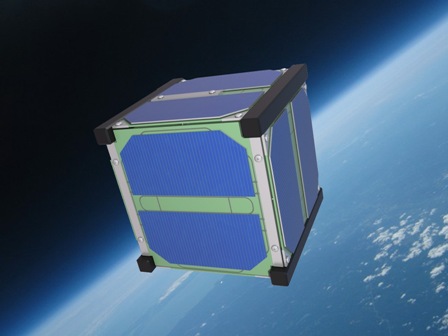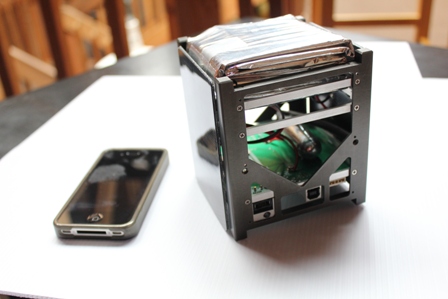
Amateur astronomer Tim DeBenedictis has decided to send a satellite up into space. DeBenedictis, who was too young to remember Neil Armstrong walk on the moon, does vividly remember the Challenger exploding in 1986. His fascination with outer space really came to life during the space shuttle Voyager missions, when outer moons were discovered. That's when they truly became real to him.
Due to NASA budget cuts and technical difficulties, the last Space Shuttle launch was in 2011. DeBenedictis, who was fortunate to have a friend who had won tickets to the launch, was there for the final Atlantis launch (STS-135) in July 2011. At this point, DeBenedictis' company, Southern Stars, which primarily functions as a mobile app company, was already extremely successful. Around the same time, the company released a new version (v3) SkySafari iPhone apps, and it started making a lot of money for Southern Stars. The company began contemplating their own space mission. DeBenedictis admits that although the idea was "fun," the reality of it was that orbital rocketry was beyond their capabilities.
However, during their research, they came across the concept of CubeSats: little university satellites that "piggyback" onto a larger rocket launch, for a "relatively" inexpensive ride into space. About 150 CubeSats have been launched since the early 2000s, when they were pioneered at Stanford University by professor Bob Twiggs, according to DeBenedictis. South Stars realized then that a CubeSat mission was within their technical abilities.
Photo of the real SkyCube model showing the actual size of the satellite compared to an iPhone
SkyCube is a 1U CubeSat that will launch on a SpaceX Falcon 9 rocket. SkyCube will take images of the Earth, and broadcast simple 120-byte messages uploaded by sponsors. It will communicate at 915 MHz with a brand new network of CubeSat ground stations. Southern Stars has purchased a launch on SpaceX Falcon 9 rocket in 2013. Currently, the rocket is set to launch in March. SpaceX is the first private company that has flown a cargo capsule to and from the International Space Station. The launch will take place from Cape Canaveral AFS, Florida. After deployment, SkyCube will orbit for about 90 days, taking images of the Earth and broadcasting sponsors' messages. They may go a bit longer, depending, since the FCC license allows up to six months of operation. At the end of that period, they will inflate the balloon, and three weeks after that, SkyCube comes down.
SkyCube is Southern Stars' first orbital space mission. They've developed apps that let people explore the night sky. Now, they're launching something that lets people go a step further. From an iPhone (or Android), consumers will be able to request an image from the satellite, orbiting 600 kilometers above the Earth. They will be able to send a message to SkyCube from their phone as well, which it will then broadcast at 915 MHz into deep space. SkyCube will also broadcast the message back down to Earth as well, therefore, people with amateur radio gear can hear it, and so can anybody else with a smartphone. In addition, SkyCube messages will be reflected in the satellite's Twitter stream which will be created prior to the launch. SkyCube is being designed and built now by Astronautical Development, LLC, whose CubeSat radios have a 100 percent successful track record in space.

Four simulated images showing exactly the field of view of SkyCube's cameras from 600 km up in orbit
SkyCube will be visable with the naked eye, no telescope is needed. At the final stage of the mission, SkyCube will inflate an onboard balloon to about 10 feet in diameter. The balloon will appear as a bright star, and it'll be a transformative moment for kids, parents, teachers, students, and anyone else who helped put it up there.

Image of NASA's NanoSail-D (about the same size as SkyCube's inflated balloon) crossing the sky, along with their iPhone app
The balloon serves a second purpose: it will rapidly drag SkyCube out of orbit. Atmospheric drag on the balloon will pull the satellite out of orbit about three weeks after it is inflated. SkyCube will eventually flash into the upper atmosphere, like a meteor, and vaporize cleanly. SkyCube will actually be the first CubeSat to de-orbit itself deliberately when its mission ends. Southern Stars hopes to set a precedent for future CubeSat missions. Their space balloon manufacturer is Global Western, an aerostat expert whose past clients include NASA and JPL.
Costs for SkyCube total about $200,000, with the launch taking up $125,000 of that total. Operational costs will mostly be free since SkyCube is utilizing a network of ground stations operated by the US Navy for its own and other University CubeSat projects.

Engineering drawings of SkyCube packed for launch, deploying solar panels, and fully operational
Consumers have purchasing options that include 10 seconds of the mission and a unique 12-byte broadcast from space for $1. Six dollars will provide the consumer with 60 seconds, a broadcast and a photograph of the Earth taken from the satellite at the time of their choosing. Many other purchasing options are available, including some that include VIP seating at the actual launch. Corporate sponsorship is also available. Complete details about the mission are their website.
Photos courtesy of Southern Stars

